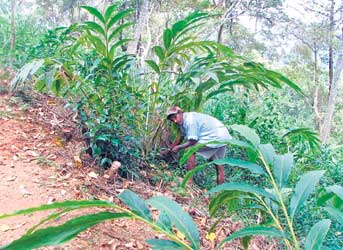
| Cardamom output’s not the issue, selling is Bumper yields were harvested by cardamom growers in the Kandy district due to the monsoon. Cardamoms require a cool climate as found in the hill country, well distributed rainfall and forest cover. The Knuckles area is perfect for cardamom growing but is restricted in this region. New plantations are illegal but old plantations exist and they flourish due to the ideal conditions. The Kandy Times met with a cardamom grower who owns a smallholding of 25 acres. He was expecting 300 kilos of fruit but explained that if it is cultivated properly, that is with manure, pesticides etc. that he could get about 900 kilos from his plantation. It was interesting to listen to his reasons for not investing in cardamoms. Controlling theft was almost impossible, he said, as it was not feasible to employ more than one watcher. Crops were severely damaged by wild boar and monkeys – both menaces were also impossible to eradicate. Once the cardamoms are picked they have to be fired (dried in hot air barns) within two days. There are several old plantations that have the infrastructure to fire cardamoms but find that it is not profitable to do so. Consequently the crop is sold to ‘enasal maduwas’ (cardamom barns). There are several of these middle-men who conduct a lucrative business in this area collecting cardamoms from small holdings. They are secretive about their final market. These middle men hold the ace as they grade the crop and determine the price to be paid, the grower is in no position to demand as he has to dispose of his produce within the limited time period of one to one and half days.
An officer attached to the Agriculture Department, Kandy says that the reason for the restriction of cardamom growing in the Knuckles region was because of the operation of firing barns. Though it is a fact that cardamoms are grown under forest cover and clearing of forests is not necessary, trees are cut indiscriminately to be used as firewood to dry the cardamoms and this causes severe destruction of forests. Special skills Middle-man’s perspective Mafia at the Cardamom Auctions? Every one of them had taken their cardamoms to the auctions and found that it was a no-win situation there; they never got an acceptable price. This same sentiment was echoed by several growers who had tried taking their cardamoms direct to the auctions. They explained that three to four people control the bidding and that buying prices are never allowed to go high. “Long gone are the days that cardamoms fetched even Rs 1,000 a kilo; there is a mafia at work here” was one comment. “This is a small income earner, so the authorities are not really interested in streamlining or regulating the auctioning process.” “When we don’t get a good price at the auctions and can get much better prices outside, why should we go to the auctions?” These were some of the comments and are also the reasons why the growers who have firing barns do not bother to dry their own cardamoms. The price they get from the auctions barely cover their costs, sometimes even not and they do not have other contacts to sell the cardamoms to. As such it is practical to sell the green cardamoms to the middle-man. The cardamom grower interviewed concluded that it was his personal opinion that in these circumstances it was not worthwhile to invest in his property by way of employing more watchers to safeguard the plantation or even manuring as his profits were marginal. “It is a pity” he said. “It is a fairly easy crop to maintain, which yields a harvest every 45 days and I’m sure growers will take more interest if they can obtain good profits”. |
| || Front
Page | News
| Editorial
| Columns
| Sports
| Plus
| Financial
Times | International
| Mirror
| TV
Times | Funday
Times | Kandy
Times || |
| |
Copyright
2006 Wijeya
Newspapers Ltd.Colombo. Sri Lanka. |
